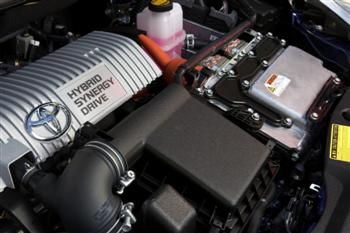|
Home | News | Road Tests | ||||||||||||
Toyota Prius: Not All Hybrids Are Equal
Toyota's next-generation Prius is powered by Hybrid Synergy Drive, the undisputed reference point for hybrid technology. Unlike most of its competitors, the Hybrid Synergy Drive technology in Prius is an uncompromised system. It allows the new Toyota Prius to operate on petrol alone, electric power alone, or a combination of both - and it can also charge the hybrid battery while the car is running. These are the capabilities that set Prius apart from other hybrids. In the third-generation Prius, Toyota engineers have made comprehensive improvements to this award-winning Hybrid Synergy Drive technology. They have redesigned 90 per cent of the hybrid drive components so they deliver more power and better fuel economy, while being lighter and more compact. There are three types of hybrid system - series, parallel and Toyota's Hybrid Synergy Drive, a series-parallel hybrid that combines the best features of the other two systems. A series hybrid has an on-board internal combustion engine (petrol or diesel) that never drives the wheels. Instead, it provides power to an electric motor which is permanently connected to the wheels - such as in a railway locomotive. Mass-produced series hybrid cars do not exist, although another car maker has announced plans to produce such a vehicle in the future. A parallel hybrid uses an internal combustion engine as the main power source, while a small electric motor assists with acceleration. The battery and electric motor in a parallel hybrid are not powerful enough to move the car from a standing start on electric power alone.
Parallel hybrids are quite efficient on the highway, but relatively inefficient in stop-and-go driving. Toyota's Hybrid Synergy Drive has the potential to perform better than either of the other systems alone with power allocation controlled to gain the best efficiency. In the Toyota Prius, an electric motor is used for start-up and for low to mid-range speeds. In normal cruising, both the engine and the electric motor drive the wheels; surplus engine power is used to recharge the battery. Under hard acceleration, the battery supplies additional energy, while the engine and motor provide smooth acceleration response. When the driver brakes or slows down, the motor recovers the kinetic energy that is normally lost as heat, converts it into electricity and stores it in the battery - a feature known as regenerative braking. The petrol engine automatically switches off when the car is stationary or coasting, which saves fuel and reduces exhaust emissions. At low speeds, a Prius driver can also push a button on the dashboard to select electric drive for short distances, such as in stop-start driving in heavy traffic. Prius requires no special training to drive. Its computer-controlled epicyclical constantly variable transmission allows the car to operate in a similar way to an automatic with no perceptible gear ratio changes. Prius has a "B" position on the shifter that works just like selecting a lower gear on a conventional automatic transmission - except that it increases regenerative braking. Driving downhill, it will increase the amount of energy recovered, boosting hybrid battery levels. The blended series-parallel approach of Hybrid Synergy Drive makes more sense to Toyota than the alternatives. Toyota's third-generation Prius will go on sale in Australia during July. | ||||||||||||
More Toyota News .....
here
About | Car Clubs | Home | News | Road Ramblings | Road Tests | Subscribe | Top Drive © 2009 All rights reserved. Next Car Pty. Ltd. |




